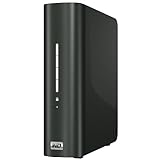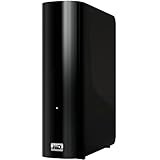Western Digital My Book Studio II – 6 TB (2 x 3 TB) USB 2.0/FireWire 800/400/eSATA Desktop External Hard Drive
http://ecx.images-amazon.com/images/I/4129tNvX%2BQL._SL160_.jpg
- Performance for creative pros
- Quad interface.
- Formatted for Mac
- Compatible with Apple Time Machine
- 30% power reduction and RAID 1/0
- RAID 1/0, User serviceable
WD’s My Book Studio Edition II dual-drive external storage system for Mac offers performance for creative professionals. Includes up to 6 TB of storage, RAID, quad-interface, user-serviceability, a 5-year limited warranty, and is compatible with Apple Time Machine.
Desktop Backup Drive
Western Digital My Book Studio II – 6 TB (2 x 3 TB) USB 2.0/FireWire 800/400/eSATA Desktop External Hard Drive
List Price: $ 549.99
Price:
















WD admits there is a firewire “technical limitation.”,
I have been using the WD Studio II 2TB on my 2008 iMac OSX 10.5.6 for two weeks. Connection: firewire 800. Today, it did not mount when I booted the computer.
Checked the WD Website Knowledge Base.
Discovered two things:
1. Knowledge Base Answer 1697: “This issue is caused by the external hard drive’s built in auto on/off functionality not correctly receiving a command from the computer system to wake from a power saver mode.”
Why does the auto on/off functionality not correctly receive the command from the computer system? WD goes on to suggest installing their WD Drive Manager.
Well, WD Drive Manager is already installed, how else could a user have arrived at this impasse to begin with?
And then they suggest to dismount the drive. How do you dismount an unmounted drive?
2. Knowledge Base Answer 1680: “This is an technical limitation between the FireWire interfaces on the Macintosh computer and the external hard drive.”
By “the external hard drive” WD means THEIR brand of external hard drive. I have never had this specific problem with any other brands of external hard drives connected to my Macintosh computer.
When is WD going to fix this “technical limitation” that they have built into their Studio II external hard drive? I would say, that is a pretty serious “technical limitation.”
1680 goes on to explain the workaround solution, essentially a routine disconnecting the power cable and reconnecting. Nice.
My hope is that this entire situation is the result of following the apparently misleading instructions shown in the Studio II manual: chapter 7, “Turning Off/Disconnecting the Device.”
Since “Auto-off” is the first entry in this chapter, it leads the user to believe that this is the preferred way to operate the drive. Guess not: as it turns out, the hidden “technical limitation” of the firewire connection will eventually cause the problem I have described. I suppose I can’t rely on “Auto-off.” Use “Safe Shutdown” only, even though the instructions in the manual differ from the instructions presented in WD Knowledge Base Answer 976!
And, speaking of conflicting instructions, compare WD Knowledge Base Answer 1386 with the Auto-off instructions in the manual.
Based on all of this information from WD, conflicting and otherwise, my guess is that the Auto-off feature is problematic (at least with Macintosh computers) because of firewire “technical limitations” caused by the WD external drive design. This fact, if it is a fact, should be expressed clearly in the manual.
Was this review helpful to you?

|Not best for Intel Macs,
I purchased this drive to go along with my intel mac. I was previously a happy lacie owner, but since WD came in at such a great price and was listed as great with macs, I went for it.
What a mistake. For the first month, it worked well… a bit slower than my lacie, but still worked. Then, all of the sudden, it began to dismount itself from my computer. I am currently using Lightroom to edit my work, and when the drive would fail, Lightroom would loose the catalog. When you have 500+ images to edit and the drive dismounts every 45 minutes, this can become a huge issue.
So, I did some further research and found out that several other intel mac users are having the same issue with this product. This is very frustrating as it is advertised ‘for your mac’. Most of the other posters mentioned that the drive worked well for about a month and then started having issues.
I called WD, and their customer service department was actually very helpful. The offered to send me a new unit, even though that unit would likely have the same issue down the line. I understand that there was not much they could do for me at WD, but they were concerned and helpful just the same.
Luckily for me, the customer service dept at Amazon is rockin’ awesome and is allowing me to exchange the WD for 2 lacie units even though I am slightly past the 30 day return policy mark. While I have never had to return an item to Amazon before, I am very comforted to know that the customer service dept is really looking out for their customers.
If you are using an intel mac, I would move on from this product. It is not worth the headache. However, you can feel confident making your purchase from Amazon…
Was this review helpful to you?

|Some technical tips on this great drive for Windows Vista or Windows 7, very big and reliable and inexpensive,
[Updated this review on 28-Jun-2011]
I have purchased 4 of these Western Digital Studio II external hard drives over the past 18 months (three of them are 4TB, one of them is 6TB), and they are great. The first 3 of these I bought have been chugging along with constant use for more than a year, with nary a hiccup. I just purchased the 6TB model about a week ago, and it looks identical to the 4TB models — I have high hopes for it as well.
For some context: In the past, I purchased 2 Iomega external drives and 4 LaCie external drives, and ALL of those external drives completely failed after a few months of use, while connected to 3 different computers. Unbelievable! But these Western Digital Studio II drives are a dream. They keep going and going…
These Western Digital Studio II drives have a choice of 4 different interfaces (USB 2.0, FireWire 400, FireWire 800, and eSATA), and I’ve used them with all of the interfaces. I’ve also used them on Windows Vista and Windows 7 (both 32-bit and 64-bit), on three different computers. No matter which interface you use, or which version of Windows, they work right out of the box, are immediately recognized by Windows, no drivers needed. No fuss, no bother, no reading the user manual, etc. (You just need to remember to format the drive for Windows; see below.)
Over the past 18 months or so, I have discovered some technical tidbits about using these drives that I wanted to pass along, because it might help someone who is stuck. Most of this information applies to any large external drive that you attach to a Windows computer; this info is not necessarily specific to these Western Digital drives.
So, here are some technical tips when using these Western Digital My Book Studio II drives:
1. When you receive the drive, it is formatted for the Mac, rather than Windows. No problem, you just need to format it for Windows, which takes less than a minute. IMPORTANT: When you are formatting the drive for Windows, you MUST use the USB 2.0 port on the drive (with a USB 2.0 cable — included with the drive) to format it. After that, you can use any of the interfaces (USB 2.0, FireWire 400 or 800, or eSATA) to access the drive. If you try to format the drive while connected to your computer with eSATA, your computer will only see about half of the drive’s capacity. Again, this only affects initial formatting. After formatting, use any interface, and your computer will see the full capacity of the drive. HOW TO FORMAT: Choose Start, right-click on Computer, choose Manage, and select Disk Management. You probably know the drill from there, but if not, see the documentation that comes with the drive. Do a “Quick Format” — no need to do the lengthy normal format.
2. The fastest port on these drives is the 3Gbit/sec eSATA port. If you only have one eSATA port on your computer, and you have more than one of these drives (like me), you might think you can use an eSATA external port multiplier to turn your one eSATA port on your computer into multiple eSATA ports so you can connect multiple external drives to one eSATA port on your computer. However, this only works if the eSATA port on your computer supports an eSATA port multiplier. Some computer eSATA ports do not (for example, I have a Dell XPS 17 laptop, and its eSATA port does not support an eSATA port multiplier). If you are in this situation, or if you don’t have any eSATA ports at all on your computer, but you DO have a USB 3.0 or SuperSpeed USB 3.0 port on your computer, you are golden. You can use a StarTech.com USB3S2ESATA 3 Feet SuperSpeed USB 3.0 to eSATA Cable Adapter or similar product, which is a USB 3.0 to eSATA adapter cable, to connect the eSATA port on your external drive to the USB 3.0 port on your computer. Most USB 3.0 ports run at 5Gbit/sec, and even though most eSATA ports only run at 3Gbit/sec, this adapter cable lets you use the drive at 3Gbit/sec from your computer’s USB 3.0 port, which is 6 times faster than the slow 480Mbit/sec speed of a USB 2.0 port connection.
3. I discovered, on my computer, that when I attached one of these drives to my laptop computer via my computer’s eSATA port, that my computer would no longer reboot successfully, unless I unplugged the eSATA cable and plugged it back in after my computer got past the initial stages of rebooting. This is not the fault of the drive. As noted on the Western Digital knowledge base on their web site, the BIOS of many computers cannot recognize hard drives larger than 2TB (even though Windows Vista and Windows 7 can recognize much larger drives), so the BIOS stops rebooting when it sees my huge 4TB or 6TB drive plugged into the eSATA port on my computer. I rebooted my computer and…
Read more
Was this review helpful to you?

|